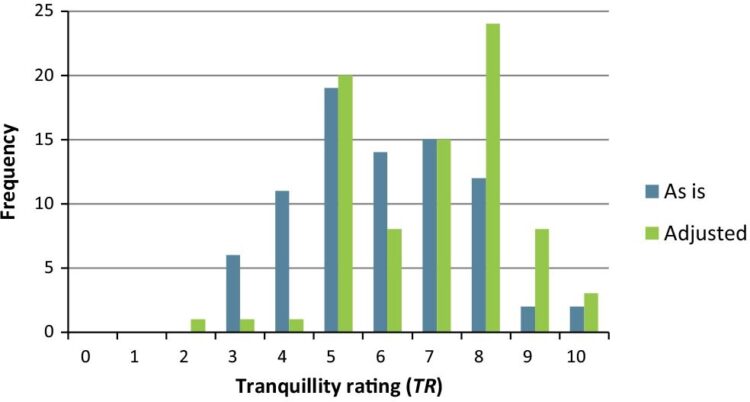June 9, 2020
Acoustics + Stress
Acoustics - Stress Research Brief
Summary
When implemented well, acoustic design can create positive, calming, restorative environments that reduce user stress. Poor acoustic conditions serve as illustration of arousal theory, suggesting environmental factors influence the brain’s level of excitement. Overstimulation and stress can lead to learned helplessness, frustration, social deprivation, and inference of daily activities.
Overview
I. Decreased Hospital Staff Stress
Studies conducted by Mackrill as well as Ratcliffe illustrate that certain natural sounds such as the sound of birds may offer benefits that contribute to a positive feeling, perceived restoration of attention and stress recovery (Iyendo 2016). Study suggested that environmental manipulations had different effects on blood-donor stress. In the case of the Nature versus Urban comparison, pulse rate was markedly lower when donors were exposed to Nature. This finding supports the interpretation that stress was lower during the Nature rather than Urban videotape and is consistent with evidence from other research that exposure to nature can reduce stress (Ulrich 2003).
Findings indicate that improved acoustics affected the psychosocial environment in such a way that during the afternoon the staff experienced reduced demands, and less pressure/strain. During the study period with the sound absorbing acoustics the staff reported that they also felt more relaxed (Blomkvist 2005).
II. Decreased Patient Stress
Healthcare environments tend to be restorative for stressed outpatients if nature is present and if stimulation levels are low rather than high and intrusive (Ulrich 2003, 45). Physiological and psychosocial data suggested that recovery from stress was faster and more complete when subjects were exposed to natural settings as opposed to the other environments (Daykin 2008, 91).

Tranquility Scores. Graph of self-reported tranquility in relation to frequencies emitted by radios in hospital waiting rooms and the significant improvement between untreated, “as-is”, conditions and acoustic adjustments to the space (Iyendo 2016).
III. Arousal Theory vs. Control Theory
Arousal theory suggests that environmental factors influence the brain’s level of arousal. Stress experienced by healthcare consumers will be worsened by environments with high levels of stimulation or arousal properties (complexity, intensity, movement), whereas low-stimulation environments will facilitate stress reduction (Wohlwill 1983; Ulrich 1991).
Control theory contends that stress is mitigated by the provision of real or perceived control over intrusive environmental stimuli. Thusly, uncontrollable environmental stimuli would often have stressful influences. In adult patients, increases in stress, blood pressure, heart rate were commonly reported (Ulrich 2003).
IV. Acoustic Stress in Classrooms
Effects on children’s cognition include communication difficulties, impaired attention, increased arousal, learned helplessness, frustration, noise annoyance, and consequences of sleep disturbance on performance. Areas with high levels of environmental noise are often socially deprived, and children from areas with high social deprivation do worse on tests of cognition than do children not exposed to social deprivation (Basner 2014, 1329).
V. Acoustic Stress in Offices
Conversation and phones are the two highest factors related to annoyance and decreased productivity. Noise annoyance can result from noise interfering with daily activities, feelings, thoughts, sleep, or rest, and might be accompanied by negative responses, such as anger, displeasure, exhaustion, and by stress-related symptoms (Basner 2014, 1328). In severe forms, it could be thought to affect wellbeing and health, and because of the high number of people affected, annoyance substantially contributes to the burden of disease from environmental noise Both short-term laboratory studies of human beings and long-term studies of animals have provided biological mechanisms and plausibility for the theory that long-term exposure to environmental noise affects the cardiovascular system and causes manifest diseases (including hypertension, ischemic heart) (Basner 2014, 1328).
VI. References
Review Articles
- Basner, Mathias, Wolfgang Babisch, Adrian Davis, Mark Brink, Charlotte Clark, Sabine Janssen, and Stephen Stansfeld. “Auditory and non-auditory effects of noise on health.” The Lancet 383, no. 9925 (2014): 1325-1332.
- Blomkvist, Vanja, Clair Anne Eriksen, Töres Theorell, Roger Ulrich, and Gundars Rasmanis. “Acoustics and psychosocial environment in intensive coronary care.” Occupational and environmental medicine 62, no. 3 (2005): e1-e1.
- Iyendo, Timothy Onosahwo. “Exploring the effect of sound and music on health in hospital settings: A narrative review.” International journal of nursing studies 63 (2016): 82-100.
- Ulrich, Roger S., Robert F. Simons, and Mark A. Miles. “Effects of environmental simulations and television on blood donor stress.” Journal of Architectural and Planning Research (2003): 38-47.
- Watts, Greg, Amir Khan, and Rob Pheasant. “Influence of soundscape and interior design on anxiety and perceived tranquility of patients in a healthcare setting.” Applied Acoustics 104 (2016): 135-141.
Primary Research
- Krout, Robert E. “Music listening to facilitate relaxation and promote wellness: Integrated aspects of our neurophysiological responses to music.” The arts in Psychotherapy 34, no. 2 (2007): 134-141.
- Tiesler, Gerhart, Rainer Machner, and Holger Brokmann. “Classroom Acoustics and Impact on Health and Social Behaviour.” Energy Procedia 78 (2015): 3108-3113.
Popular Press
- “Noise Exposure is Becoming ‘the new secondhand smoke’”– The Washington Post
- “The Optimal Office”– The Atlantic
